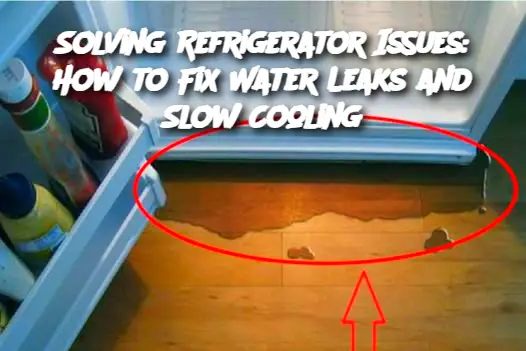Introduction:
Refrigerators are essential appliances in every household, keeping food fresh and safe for consumption over extended periods. However, like all electrical devices, they are prone to malfunction over time. Two common issues that many people experience are water leakage and slow cooling. These problems can be frustrating, especially when you’re trying to keep your food fresh. Instead of immediately calling a technician, it’s helpful to first identify the potential causes behind these issues. In many cases, simple solutions can restore your refrigerator’s functionality without the high cost of a repair service.
Ingredients (Tools and Materials Needed):
Towels or rags (to soak up excess water)
A hairdryer (to defrost frozen coils)
Baking soda and water (for cleaning)
A small brush or toothbrush (for cleaning vents and drains)
A multimeter (optional, for checking electrical components)
Replacement door seal (if necessary)
Instructions:
Identify the Water Leak Source
Start by determining where the water is leaking. It could be coming from the defrost drain, the door seal, or even the water line (if your fridge has an ice maker or water dispenser). If the leak is coming from the defrost drain, this could be blocked and will need to be cleared.
Defrost the Freezer
If the cooling process is slow, the evaporator coils may be frozen. Use a hairdryer on a low heat setting to melt the ice around the coils. Make sure to dry any water accumulated on the floor of the freezer to avoid further leakage.
Clean the Condenser Coils
Dust or dirt on the condenser coils can cause poor cooling efficiency. Use a vacuum cleaner with a brush attachment or a small brush to gently clean the coils located on the back or underneath the refrigerator.
Inspect the Door Seal
A faulty door seal can allow warm air into the fridge, which can cause it to cool slowly. Check the rubber seal around the door for cracks or tears. If you notice any damage, replacing the door seal is an easy and inexpensive fix.
Clear the Drainage System
If water is leaking inside the fridge, the drainage system may be clogged. Use a small brush or a pipe cleaner to clear out any debris from the defrost drain. You can also flush the drain with warm water mixed with baking soda to prevent buildup.
Check the Thermostat and Temperature Settings
Sometimes, slow cooling is due to incorrect temperature settings. Ensure the fridge is set to the optimal temperature, usually between 37°F (3°C) and 40°F (4°C). If the thermostat is malfunctioning, it may need to be repaired or replaced.
Tips for Serving and Storing:
ADVERTISEMENT

